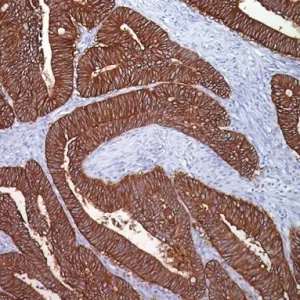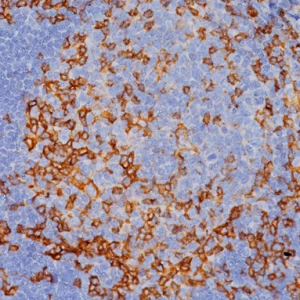Description
STAT6 (signal transducer and activator of transcription 6) is a member of the STAT family of cytoplasmic transcription factors, which regulate gene expression by transmitting signals to the nucleus and binding to specific DNA promoter sequences. STAT6 is composed of a DNA-binding domain, a C-terminal transcriptional activation domain, and a SH2 domain. STAT signaling is critical for cellular processes such as embryonic development, immune tolerance and tumor surveillance, and regulation of cell differentiation, growth, and apoptosis. (1,2) Nuclear expression of STAT6 is found in nearly all cases of solitary fibrous tumor (SFT) and is very limited in other soft tissue neoplasms making it a highly sensitive and specific immunohistochemical marker for SFT and may help to distinguish this tumor type from histologic mimics. Recently, STAT6 has received considerable attention in the area of tumor growth and metastasis. Significantly higher STAT6 immunoexpression level was observed in non-small-cell lung cancer (NSCLC); specifically, higher expression was found in squamous cell carcinoma than in large-cell carcinoma. (2,3)
SPECIFICATIONS
Specifications
| INTENDED USE | IVD |
|---|---|
| CLONE | YE361 |
| SOURCE | Rabbit Monoclonal |
| SPECIES REACTIVITY | Human; others not tested |
| ISOTYPE | IgG |
| POSITIVE CONTROL | Solitary Fibrous Tumor |
DATASHEETS & SDS
REFERENCES
1. Ahmad Z, Tariq MU, Din NU. Meningeal solitary fibrous
tumor/hemangiopericytoma: Emphasizing on STAT 6
immunohistochemistry. Pathological Panorama. 2018; 66(5) 1419-26.
2. Doyle L, et al. Nuclear expression of STAT6 distinguishes solitary
fibrous tumor from histologic mimics. Mod Pathol. 2014 Mar;
27(3):390-5.
3. Fu C, et al. Activation of the IL-4/STAT6 Pathway promotes lunch
cancer progression by increasing M2 myeloid cells. Front Immunol. 2019
Nov; 10:2368.
4. Center for Disease Control Manual. Guide: Safety Management, NO.
CDC-22, Atlanta, GA. April 30, 1976 “Decontamination of Laboratory
Sink Drains to Remove Azide Salts.”
5. Clinical and Laboratory Standards Institute (CLSI). Protection of
Laboratory Workers from Occupationally Acquired Infections; Approved
Guideline-Fourth Edition CLSI document M29-A4 Wayne, PA 2014.







Reviews
There are no reviews yet.